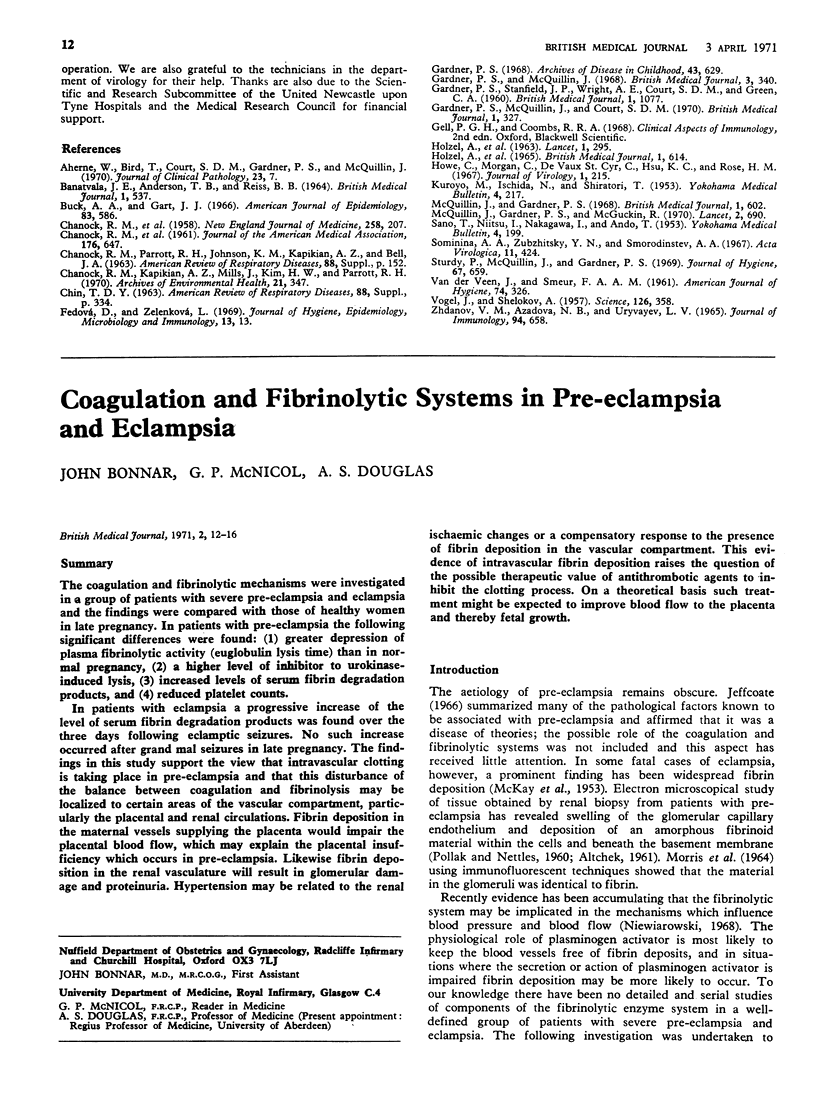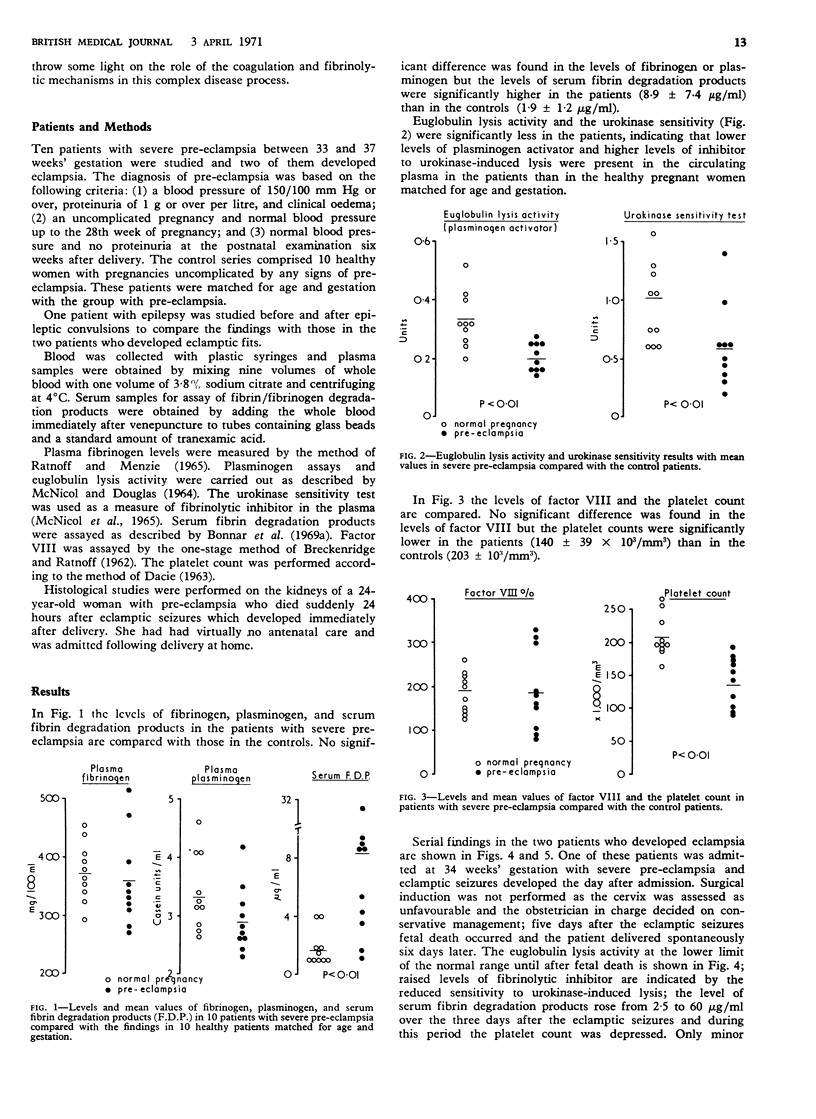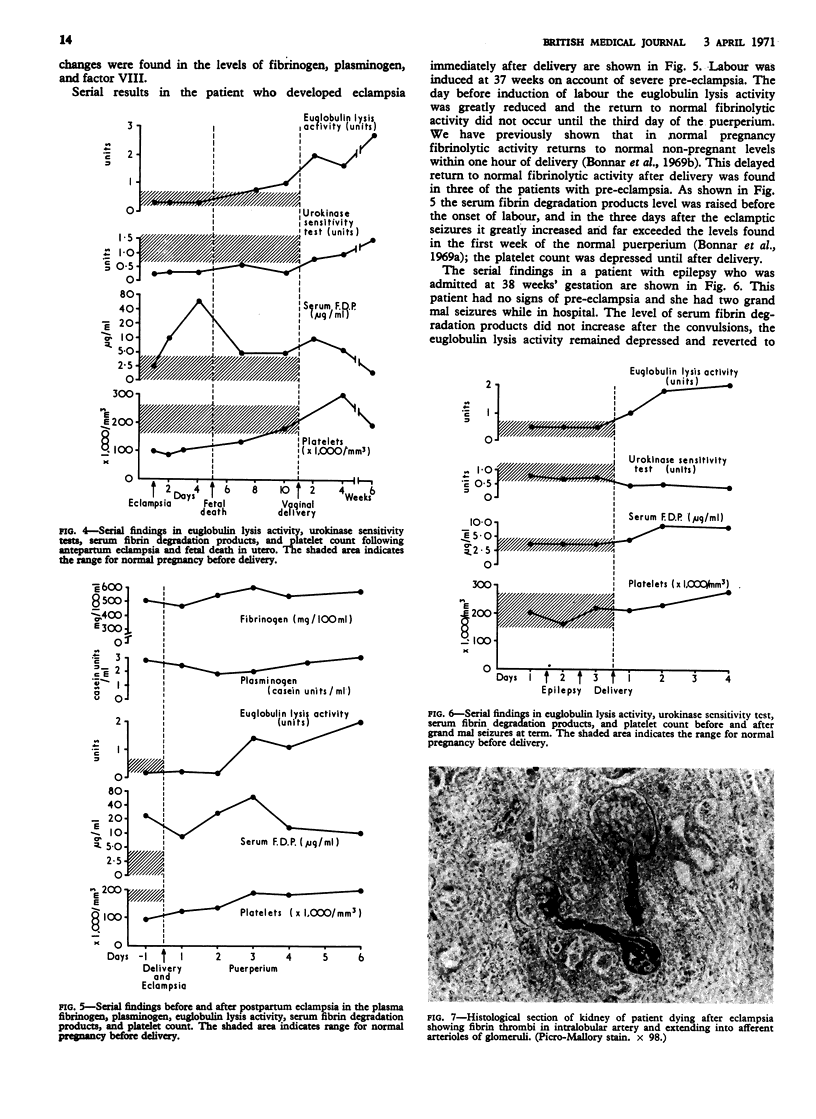Abstract
The coagulation and fibrinolytic mechanisms were investigated in a group of patients with severe pre-eclampsia and eclampsia and the findings were compared with those of healthy women in late pregnancy. In patients with pre-eclampsia the following significant differences were found: (1) greater depression of plasma fibrinolytic activity (euglobulin lysis time) than in normal pregnancy, (2) a higher level of inhibitor to urokinaseinduced lysis, (3) increased levels of serum fibrin degradation products, and (4) reduced platelet counts.
In patients with eclampsia a progressive increase of the level of serum fibrin degradation products was found over the three days following eclamptic seizures. No such increase occurred after grand mal seizures in late pregnancy. The findings in this study support the view that intravascular clotting is taking place in pre-eclampsia and that this disturbance of the balance between coagulation and fibrinolysis may be localized to certain areas of the vascular compartment, particularly the placental and renal circulations. Fibrin deposition in the maternal vessels supplying the placenta would impair the placental blood flow, which may explain the placental insufficiency which occurs in pre-eclampsia. Likewise fibrin deposition in the renal vasculature will result in glomerular damage and proteinuria. Hypertension may be related to the renal ischaemic changes or a compensatory response to the presence of fibrin deposition in the vascular compartment. This evidence of intravascular fibrin deposition raises the question of the possible therapeutic value of antithrombotic agents to inhibit the clotting process. On a theoretical basis such treatment might be expected to improve blood flow to the placenta and thereby fetal growth.
Full text
PDF




Images in this article
Selected References
These references are in PubMed. This may not be the complete list of references from this article.
- ALTCHEK A. Electron microscopy of renal biopsies in toxemia of pregnancy. JAMA. 1961 Mar 4;175:791–795. doi: 10.1001/jama.1961.63040090005010. [DOI] [PubMed] [Google Scholar]
- BRECKENRIDGE R. T., RATNOFF C. D. Studies on the nature of the circulating anticoagulant directed against antihemophilic factor: with notes on an assay for anthemophilic factor. Blood. 1962 Aug;20:137–149. [PubMed] [Google Scholar]
- Bonnar J., Davidson J. F., Pidgeon C. F., McNicol G. P., Douglas A. S. Fibrin degradation products in normal and abnormal pregnancy and parturition. Br Med J. 1969 Jul 19;3(5663):137–140. doi: 10.1136/bmj.3.5663.137. [DOI] [PMC free article] [PubMed] [Google Scholar]
- Bonnar J., McNicol G. P., Douglas A. S. Fibrinolytic enzyme system and pregnancy. Br Med J. 1969 Aug 16;3(5667):387–389. doi: 10.1136/bmj.3.5667.387. [DOI] [PMC free article] [PubMed] [Google Scholar]
- Brain M. C., Kuah K. B., Dixon H. G. Heparin treatment of haemolysis and thrombocytopenia in pre-eclampsia. Report of a case and a review of the literature. J Obstet Gynaecol Br Commonw. 1967 Oct;74(5):702–711. doi: 10.1111/j.1471-0528.1967.tb03784.x. [DOI] [PubMed] [Google Scholar]
- HJORT P. F., RAPAPORT S. I. THE SHWARTZMAN REACTION: PATHOGENETIC MECHANISMS AND CLINICAL MANIFESTATIONS. Annu Rev Med. 1965;16:135–168. doi: 10.1146/annurev.me.16.020165.001031. [DOI] [PubMed] [Google Scholar]
- Henderson A. H., Pugsley D. J., Thomas D. P. Fibrin degradation products in pre-eclamptic toxaemia and eclampsia. Br Med J. 1970 Sep 5;3(5722):545–547. doi: 10.1136/bmj.3.5722.545. [DOI] [PMC free article] [PubMed] [Google Scholar]
- Jeffcoate T. N. Pre-eclampsia and eclampsia: the disease of theories. Proc R Soc Med. 1966 May;59(5):397–404. [PMC free article] [PubMed] [Google Scholar]
- MCKAY D. G., DEBACALAO E. B., SEDLIS A. PLATELET ADHESIVENESS IN TOXEMIA OF PREGNANCY. Am J Obstet Gynecol. 1964 Dec 15;90:1315–1318. doi: 10.1016/0002-9378(64)90854-3. [DOI] [PubMed] [Google Scholar]
- MCNICOL G. P., BARAKAT A. A., DOUGLAS A. S. PLASMA FIBRINOLYTIC ACTIVITY IN RENAL DISEASE. Scott Med J. 1965 May;10:189–194. doi: 10.1177/003693306501000502. [DOI] [PubMed] [Google Scholar]
- MORRIS R. H., VASSALLI P., BELLER F. K., MCCLUSKEY R. T. IMMUNOFLUORESCENT STUDIES OF RENAL BIOPSIES IN THE DIAGNOSIS OF TOXEMIA OF PREGNANCY. Obstet Gynecol. 1964 Jul;24:32–46. [PubMed] [Google Scholar]
- McKAY D. G., MERRILL S. J., WEINER A. E., HERTIG A. T., REID D. E. The pathologic anatomy of eclampsia, bilateral renal cortical necrosis, pituitary necrosis, and other acute fatal complications of pregnancy, and its possible relationship to the generalized Shwartzman phenomenon. Am J Obstet Gynecol. 1953 Sep;66(3):507–539. doi: 10.1016/0002-9378(53)90068-4. [DOI] [PubMed] [Google Scholar]
- PAGE E. W., FULTON L. D., GLENDENING M. B. The cause of the blood coagulation defect following abruptio placentae. Am J Obstet Gynecol. 1951 May;61(5):1116–1122. doi: 10.1016/0002-9378(51)90313-4. [DOI] [PubMed] [Google Scholar]
- POLLAK V. E., NETTLES J. B. Preliminary observations on the differential diagnosis of toxemias of pregnancy by means of renal biopsy. Am J Obstet Gynecol. 1960 May;79:866–869. doi: 10.1016/0002-9378(60)90679-7. [DOI] [PubMed] [Google Scholar]
- VASSALLI P., MCCLUSKEY R. T. THE COAGULATION PROCESS AND GLOMERULAR DISEASE. Am J Med. 1965 Aug;39:179–183. doi: 10.1016/0002-9343(65)90040-9. [DOI] [PubMed] [Google Scholar]
- Wardle E. N., Menon I. S. Fibrinolysis in pre-eclamptic toxaemia of pregnancy. Br Med J. 1969 Jun 7;2(5657):625–627. doi: 10.1136/bmj.2.5657.625. [DOI] [PMC free article] [PubMed] [Google Scholar]



